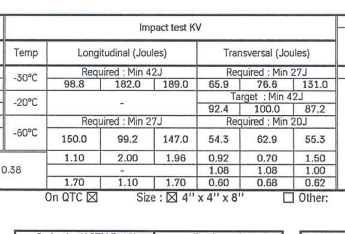API 6A includes requirements for equipment, specific to the type of equipment or component, and dependent on many factors. The bar MTR you have appears to meet the material requirements for some API 6A equipment but not all API 6A equipment. Note that a 4"x4"x8" QTC has a 5" ER. Whether the QTC size meets the API 6A requirements depends on the following:
1. Is the bar heat treated in a continuous furnace?
- if yes, then per 6.4.1 the QTC must part of a full-size bar, and this material would not meet the API 6A material requirements
- if the bar is heat treated in a batch furnace, continue to the next question
2. Is this considered a casting or a forging?
- if this is classified as a casting, then per 6.4.2.3.1, the QTC ER is required to be equal or greater than the part ER
- bar is usually hot worked, and is usually considered a forging for the purposes of 6A material requirements
- if this is classified as a forging, then continue to the next question
3. Is the equipment required to meet PSL 1 or 2?
- if yes, then per 6.4.2.3.2 the QTC ER is not required to exceed 2.5" (but may), and this material would meet the API 6A material requirements
- if no, continue to the next question
4. Is the equipment required to meet PSL 4?
- if yes, then per 6.4.2.3.2 a prolongation (same diameter as production part) or sacrificial production part is required, and this material would not meet the API 6A material requirements
- if no, continue to the next question
5. (Based on previous answers, the equipment is required to meet PSL 3 or 3G) Will this material be used for a body?
- API 6A includes many different component types, including bodies, bonnets, stems, choke beans, valve bore sealing mechanisms, and hangers
- if this material will not be used for a body, then per 6.4.2.3.2 the QTC ER is not required to exceed 5", and this material would meet the API 6A material requirements
- if this material will be used for a body, then continue to the next questions
6. Is the required yield strength of the body 75K or greater and the bar's weight during heat treat greater than 454 kg (1000 lb)?
- note that the required yield strength of the body may be lower than the minimum specified yield strength in the material specification
- it is likely that only the manufacturer (who controls the design) knows the required yield strength of the body
- the meaning/application of the required yield strength clause is not clear and may have divergent interpretations in some cases, such as when the required yield strength from the design calculations is 74.9K and the material specified on the drawing is 75K material
- if either the required yield strength of the body is less than 75K or the bar's weight during heat treat is less than 1000 lb, then per 6.4.2.3.2 the QTC ER is not required to exceed 5", and this material would meet the API 6A material requirements
- if both the required yield strength of the body is 75K or greater and the bar's weight during heat treat is greater than 1000 lb, then continue to the next question
7. Has the exception in 6.4.2.3.2 (which requires specific design documentation and qualification forging testing) been invoked by the manufacturer?
- if the exception has been invoked by the manufacturer (and the requirements for the exception met), then per 6.4.2.3.2 the QTC ER is not required to exceed 5", and this material would meet the API 6A material requirements
- if the exception has not been invoked by the manufacturer, then per 6.4.2.3.2 the QTC ER is required to match or exceed the part ER up to 250 mm (10 in.), and this material would not meet the API 6A material requirements


